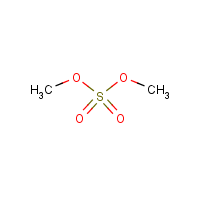Dimethyl sulfate
Agent Name
Dimethyl sulfate
CAS Number
77-78-1
Formula
C2-H6-O4-S
Major Category
Toxic Gases & Vapors

Synonyms
DMS (methyl sulfate); Dimethyl monosulfate; Dimethyl sulfate; Dimethyl sulphate; Dimethylester kyseliny sirove [Czech]; Dimethylsulfaat [Dutch]; Dimethylsulfat [Czech]; Dimetilsolfato [Italian]; Dwumetylowy siarczan [Polish]; Methyl sulfate; Methyl sulfate (VAN); Methyle (sulfate de) [French]; Sulfate de dimethyle [French]; Sulfate dimethylique [French]; Sulfato de dimetilo [Spanish]; [ChemIDplus] UN1595
Category
Other Toxic Gases & Vapors
Description
Colorless, oily liquid with a faint, onion-like odor; [NIOSH]
Sources/Uses
Used as a methylating agent in the synthesis of many organic compounds; [ACGIH]
Comments
Dimethyl sulfate causes blistering and ulceration of the skin. In cases of industrial poisoning, workers experienced burning eyes first and then respiratory symptoms, including irritation of the nose and throat, chest pain, cough, and dyspnea. Persistent abnormalities in liver function following exposure have been reported. Death is due to circulatory failure. In the presence of water vapor, dimethyl sulfate readily hydrolyzes into methanol and sulfuric acid. [ACGIH] Causes second or third degree burns after short skin exposure; [CHRIS] In a textile plant using dimethyl sulfate to produce surfactants, air levels were low but workers in one building had high blood levels secondary to skin absorption. [Schettgen T, Broding HC, Angerer J, Drexler H. Dimethyl sulphate; a hidden problem in occupational medicine. Occup Environ Med 2004;61:73-75] Dimethyl sulfate causes no known injury to the liver in experimental animals or humans. [Zimmerman, p. 368] A corrosive substance that can cause pulmonary edema; Can cause effects on the liver, kidneys, and CNS; [ICSC]
Biomedical References
Exposure Assessment
Skin Designation (ACGIH)
Yes
TIH
Yes
TLV (ACGIH)
0.1 ppm
PEL (OSHA)
1 ppm
IDLH (NIOSH)
7 ppm
Excerpts from Documentation for IDLHs
The chosen IDLH is based on the statement by Patty [1963] that a 20minute exposure to 13 ppm caused severe symptoms in monkeys and a 20minute exposure to 75 ppm resulted in the LC50 for guinea pigs [Ghiringhelli et al. 1957; Ghiringhelli and Sironi 1958].
Vapor Pressure
0.677 mm Hg
Lethal Concentration
LC50 (rat) = 45 mg/m3/4 hr
Explanatory Notes
Flash point = 182 deg F; VP from HSDB;
Reference Link #2
NFPA
high ambient temp required
Adverse Effects
Toxic Pneumonitis
Yes
Hepatotoxin
Hepatoxic (a) from occupational exposure (secondary effect) or (b) in animal studies or in humans after ingestion
Dermatotoxin
Skin burns
IARC Carcinogen
Probable (2a)
NTP Carcinogen
Anticipated human carcinogen
ACGIH Carcinogen
Confirmed Animal
Diseases, Processes, and Activities Linked to This Agent
Diseases
Occupational diseases associated with exposure to this agent: